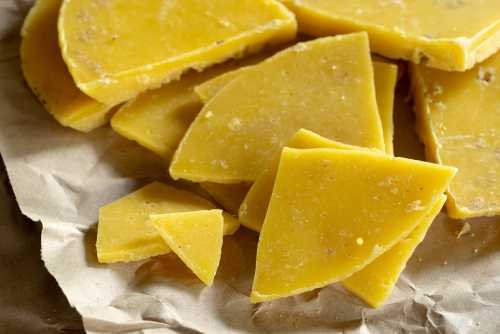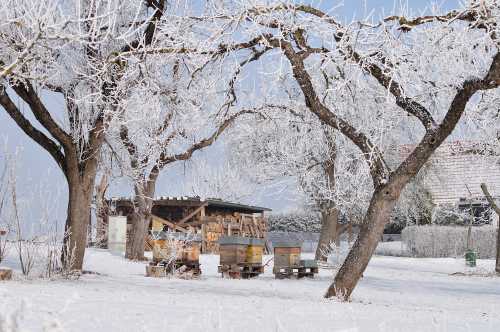Beekeeping Calendar
In truth, weather pattern variations (including unusual or ‘freak’ incidents) means that a ‘one-size fits all’ beekeeping calendar is not really possible.
There can be a general guide as to some of the seasonal activities of a beekeeper, but beekeeping will always require common sense flexibility to respond to any challenges that may crop up from time to time.
If you found this page helpful or interesting, I'd really be grateful if you would share it with others - if not this page, perhaps another, such as Gardening For Bees.
Thank you so much :) .
Beekeeping Calendar – A Rough Seasonal Guide For Hive Management

The following beekeeping calendar, is therefore only a rough ‘seasonal guide’ for hive management.
Early
Spring:
Cool to very cold or even freezing temperatures can persist in early spring in temperate regions. Despite this, on clear days, bees may fly out to forage on early blossoming shrubs and trees, such as heathers and Mahonias.
- Heft the hives to check for food stores. Provide food if bees need to be fed, but
avoid opening the hive, instead make use of the crown board.
If using a top bar hive, place fondant on the hive floor just inside the follower boards. If you feed honey to your bees, it must be their own. - Continue to monitor the weather frequently, as
well as availability of food from local flora, such as tree blossoms etc. Do you need to continue feeding your bees?
- Check the hive is in good repair, especially
around the entrance. Carefully perform any damage.
- Change the floor of the hive, removing any detritus and inspecting for any signs of disease or Varroa infestation, and treat if necessary.
Mid-late
spring:
Wait for warm days to quickly inspect the hive more closely As the weather warms, the colony will grow, and be prepared to provide syrup if necessary.
- Remove any honeycomb that has become dark with
age, and any detritus.
- Remove the mouse guard.
- Top bar hives do not use queen excluders. However, if you are using a conventional hive and a queen excluder, make sure it has not been filled
with propolis.
- Check the queen’s health – is she healthy and laying
well?
- Check for signs of disease or pests in the hive.
- Add additional frames, especially if there are
plenty of trees in blossom nearby.
- Keep a look out for signs of swarming as the weather warms. Consider preparing yourself with a ‘bait hive’.

Early
summer
The queen should be at her peak egg-laying. There should be plenty of capped brood, and workers tending eggs and larvae.
- Continue to look out for signs of swarming.
- Add an extra super if you think the bees need
more room.
- If your bees have been on oilseed rape, you may
want to remove honey before it granulates on the comb.
- Continue to check for pests and diseases, especially Varroa, and check up on the queen.

Mid-late
summer
Bees are less likely to swarm now, but keep a look out for signs.
- Add extra supers as necessary, make sure the bees are capping cells in the lower super.
- Extract honey, but don’t get greedy! The bees will need plenty to sustain them for the winter ahead.
- Render any wax for use in various ways, such as candle making.
- Continue to check for pests and diseases.
- Wasps colonies will be growing and will become more active late summer through autumn, so help your bees to defend themselves by narrowing the entrance into the hive.
- Clean or replace dirty frames.

Autumn
Time to think of preparing the bees to survive the winter.
- Check the bees have sufficient food stores,
if not you will need to supplement their feed.
- Fit a mouse guard.
- Limit inspections, but continue to look out for
disease, pests such as wax moth, wasps,
and also robber bees.
- Your hive may need to withstand challenging
weather conditions. Ensure your hive is
sturdy, secure, stable, fits together properly with minimal gaps for draughts
or pests, but do allow bees to glue up the hive with propolis.
Does your hive need to be weighed down to add stability ? A strap will help ensure the hive holds together properly. - Add insulation to the top of the hive. A rug or piece of carpet may be used.
If you are using a top bar hive, your design may allow you to add insulation under the roof, on top of the bars, and scrunched up newspaper or straw can be added in the space either side of the middle section where the bees are. - Clean away any dead drones that have been ejected
from the hive onto the landing board.
- Significantly reduce inspections and hive disturbance.
 Check for wax moth
Check for wax mothEarly to Mid Winter
- Clear away any dead bees from the hive entrance.
- Monitor the hive for signs of damage, and the surrounding location for threat of damage (e.g. from falling tree branches).
- Check hive for signs of instability and take action if necessary.
- Remember that bees may leave the hive on cleansing flights during warm days.
However, bees can get caught out by snow storms, and directly outside the hive, snow may confuse bees, possibly by reflecting ultra violet light, thus encouraging them to leave the hive.
Shovelling snow away from the hive and clearing it away from the hive entrance, may help to prevent bees flying out and exposing themselves to unpredictable weather.
Unless you have a top bar hive, you may also wish to erect a shade over the entrance of the hive. - Check the mouse guard is still in good order.
- Take the opportunity to thoroughly clean any equipment (such as your beekeeping suit, as well as your tools).

Late Winter
As winter turns to early spring, bees may fly out to forage on warm days.
- Check whether you need to feed your bees.
- Ensure the bees have access to clean, unfrozen water, in a sunny position.
- Continue to check for damage or threat of damage to the hive, and carefully carry out any repairs.

